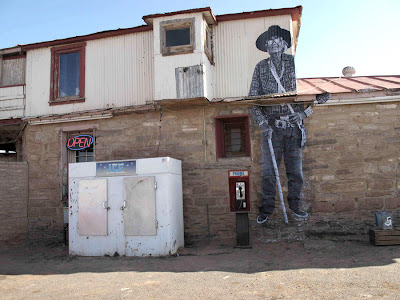Folks in Grey Mountain, AZ offering their appreciation, from Yote's flickr page
The GOAT blog, one feature of the online version of High Country News, is another site that's really worth visiting everyday. We wished the HCN a happy 40th birthday a few days ago--and there can be no better example of how this news organization has evolved and expanded its reach than the GOAT blog. It's essential reading.
The HCN's current editor, Jonathan Thompson, recently published a brief note on GOAT about an artist that I think will interest our readers:
During the last year or so, a new kind of "graffiti" has been showing up on abandoned buildings, old billboards and rusted out oil tanks on the Navajo Nation. A street artist who goes by the name of Jetsonorama (who sometimes works with another artist, Yote, and No Reservation Required) has been plastering these places with giant, black & white, cutout photographs and using wheat paste to fix them in place. They are somewhat ephemeral by nature, getting torn up by wind, rain and snow.
A little internet searching led me to what looks like Jetsonorama's blog, where I found a wealth of photos of his wheat pastes and his reflections on how the community receives this art. What I admire about his blog is that the emphasis is on the art, and not the person behind it--and he deeply respects the communities that he works with on these projects.
Jetsonorama recently posted a response to a reader that worked to explain "how a 52 year old black doctor started wheat pasting water tanks on the rez." He credits Afrika Bambaata and Zulu Nation, Keith Haring and the 80's hip hop scene in New York City as early influences that led him to consider grafitti as an art form. A later sabbatical in Brazil expanded his sense of how street art could work. Here's how the artist frames the challenges and the rewards of his project:
consequently, the project is interesting on several levels. i've had to ask myself what it means to present street art in a community that has no tradition or history of it? what does it mean to have that street art be documentary photographs of people from the community? how can i present them in such a way that some people don't feel this is a form of witchcraft?
living here makes me remain responsible for the images i put up, sensitive to the people represented and their cultural mores. if i didn't live here or know the value system, i'd put up more provocative work (like the "puppy love" series i placed in flagstaff), as opposed to straight documentary photographs. whenever i talk with people from the community about the project and what i hope to accomplish with it, i emphasize my desire to share with them the elements of the culture i consider beautiful and/or at risk of being lost. most people get that and are thankful for it.
so, it's totally liberating and invigorating for me to be able to express myself in this visual language. the whole project has provided a new way for me to interact with the community, really feel like i'm giving them love in the form of this art and to question the ephemeral nature of life.
I'm very excited to present Jetsonorama's work here, as it takes into account a number of the issues we're considering here at The Art of the Rural: urban-rural connections, how cultural traditions are re-presented in modern art forms, and how communities can transcend their own spatial and temporal boundaries to share their stories with other communities.



